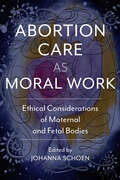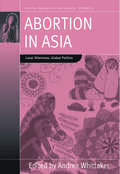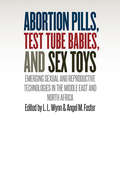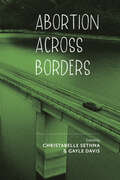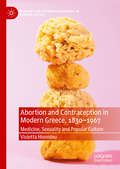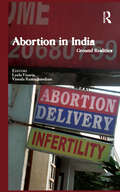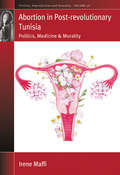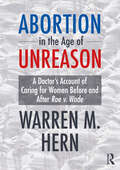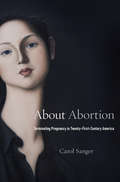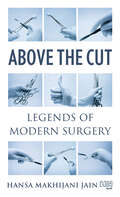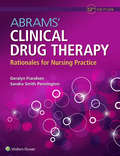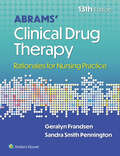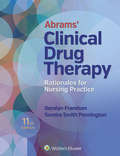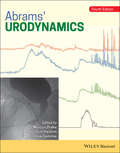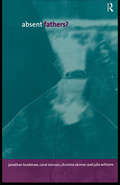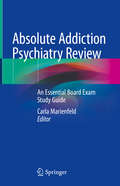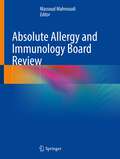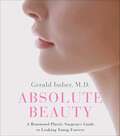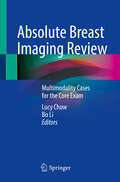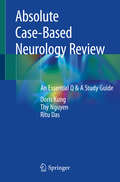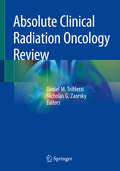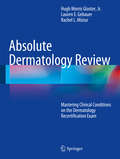- Table View
- List View
Aboriginal Health in Canada
by D. Ann Herring James Waldram T. Kue YoungNumerous studies, inquiries, and statistics accumulated over the years have demonstrated the poor health status of Aboriginal peoples relative to the Canadian population in general. Aboriginal Health in Canada is about the complex web of physiological, psychological, spiritual, historical, sociological, cultural, economic, and environmental factors that contribute to health and disease patterns among the Aboriginal peoples of Canada. The authors explore the evidence for changes in patterns of health and disease prior to and since European contact, up to the present. They discuss medical systems and the place of medicine within various Aboriginal cultures and trace the relationship between politics and the organization of health services for Aboriginal people. They also examine popular explanations for Aboriginal health patterns today, and emphasize the need to understand both the historical-cultural context of health issues, as well as the circumstances that give rise to variation in health problems and healing strategies in Aboriginal communities across the country. An overview of Aboriginal peoples in Canada provides a very general background for the non-specialist. Finally, contemporary Aboriginal healing traditions, the issue of self-determination and health care, and current trends in Aboriginal health issues are examined.
Abortion Care as Moral Work: Ethical Considerations of Maternal and Fetal Bodies (Critical Issues in Health and Medicine)
by Shannon Withycombe Colin Partridge Curtis Boyd Glenna Boyd Renee Chelian Thomas Cunningham Sarah Dubow Marc Heller Amy Hagstrom Miller Shelley SellaAbortion Care as Moral Work brings together the voices of abortion providers, abortion counselors, clinic owners, neonatologists, bioethicists, and historians to discuss how and why providing abortion care is moral work. The collection offers voices not usually heard as clinicians talk about their work and their thoughts about life and death. In four subsections--Providers, Clinics, Conscience, and The Fetus--the contributions in this anthology explore the historical context and present-day challenges to the delivery of abortion care. Contributing authors address the motivations that lead abortion providers to offer abortion care, discuss the ways in which anti-abortion regulations have made it increasingly difficult to offer feminist-inspired services, and ponder the status of the fetus and the ethical frameworks supporting abortion care and fetal research. Together these essays provide a feminist moral foundation to reassert that abortion care is moral work.
Abortion In Asia
by Andrea WhittakerThe issue of abortion forces a confrontation with the effects of poverty and economic inequalities, local moral worlds, and the cultural and social perceptions of the female body, gender, and reproduction. Based on extensive original field research, this provocative collection presents case studies from Thailand, Cambodia, Burma, Vietnam, Bangladesh, Indonesia, and India. It includes powerful insight into the conditions and hard choices faced by women and the circumstances surrounding unplanned pregnancies. It explores the connections among poverty, violence, barriers to access, and the politics and strategies involved in abortion law reform. The contributors analyze these issues within the broader conflicts surrounding women's status, gender roles, religion, nationalism and modernity, as well as the global politics of reproductive health.
Abortion Pills, Test Tube Babies, and Sex Toys: Emerging Sexual and Reproductive Technologies in the Middle East and North Africa
by L. L. Wynn Angel M. FosterFrom Viagra to in vitro fertilization, new technologies are rapidly changing the global face of reproductive health. They are far from neutral: religious, cultural, social, and legal contexts condition their global transfer. The way a society interprets and adopts (or rejects) a new technology reveals a great deal about the relationship between bodies and the body politic. Reproductive health technologies are often particularly controversial because of their potential to reconfigure kinship relationships, sexual mores, gender roles, and the way life is conceptualized. This collection of original ethnographic research spans the region from Morocco and Tunisia to Israel and Iran and covers a wide range of technologies, including emergency contraception, medication abortion, gamete donation, hymenoplasty, erectile dysfunction, and gender transformation.
Abortion Pills, Test Tube Babies, and Sex Toys: Emerging Sexual and Reproductive Technologies in the Middle East and North Africa
by L. L. Wynn and Angel M. FosterFrom Viagra to in vitro fertilization, new technologies are rapidly changing the global face of reproductive health. They are far from neutral: religious, cultural, social, and legal contexts condition their global transfer. The way a society interprets and adopts (or rejects) a new technology reveals a great deal about the relationship between bodies and the body politic. Reproductive health technologies are often particularly controversial because of their potential to reconfigure kinship relationships, sexual mores, gender roles, and the way life is conceptualized. This collection of original ethnographic research spans the region from Morocco and Tunisia to Israel and Iran and covers a wide range of technologies, including emergency contraception, medication abortion, gamete donation, hymenoplasty, erectile dysfunction, and gender transformation.Table of ContentsAcknowledgments Introduction | Setting the Context: Sexuality, Reproductive Health, and Medical Technologies in the Middle East and North Africa Angel M. Foster and L. L. Wynn Part I | Preventing and Terminating PregnancyIs There an Islamic IUD? Exploring the Acceptability of a Hormone-Releasing Intrauterine Device in Egypt Ahmed Ragaa A. RagabIntroducing Emergency Contraception in Morocco: A Slow Start after a Long Journey Elena ChopyakMifepristone in Tunisia: A Model for Expanding Access to Medication Abortion Angel M. FosterNavigating Barriers to Abortion Access: Misoprostol in the West Bank Francoise Daoud and Angel M. Foster Part II | Achieving Pregnancy and Parenthood"Worse comes to worst, I have a safety net": Fertility Preservation among Young, Single, Jewish Breast Cancer Patients in Israel Daphna Birenbaum-Carmeli, Efrat Dagan, and Suzi Modiano GattegnoThe "ART" of Making Babies Using In Vitro Fertilization: Assisted Reproduction Technologies in the United Arab Emirates Shirin KarsanWanted Babies, Excess Fetuses: The Middle East's In Vitro Fertilization, High-Order Multiple Pregnancy, Fetal Reduction Nexus Marcia C. InhornBirthing Bodies, Pregnant Selves: Gestational Surrogates, Intended Mothers, and Distributed Maternity in Israel Elly TemanC-Sections as a Nefarious Plot: The Politics of Pronatalism in Turkey Katrina MacFarlane Part III | Engaging Sex and SexualityHPV Vaccine Uptake in Lebanon: A Vicious Cycle of Misinformation, Stigma, and Prohibitive Costs Faysal El-KakHymenoplasty in Contemporary Iran: Liminality and the Embodiment of Contested Discourses Azal Ahmadi"Viagra Soup": Consumer Fantasies and Masculinity in Portrayals of Erectile Dysfunction Drugs in Cairo, Egypt L. L. WynnSex Toys and the Politics of Pleasure in Morocco Jessica Marie NewmanNarratives of Gender Transformation Practices for Transgender Women in Diyarbakir, Turkey M. A. Sanders Conclusion | Individual, Community, Religion, State: Technology at the Intersection Donna Lee BowenAcronyms and AbbreviationsGlossary of Foreign TermsBibliographyContributorsIndex
Abortion across Borders: Transnational Travel and Access to Abortion Services
by Christabelle Sethna & Gayle DavisA timely examination of how restrictive policies force women to travel both within and across national borders to access abortion services.Safe, legal, and affordable abortion is widely recognized as an essential medical service for women across the world. When access to that service is denied or restricted, women are compelled to carry unwanted pregnancies to term, seek backstreet abortionists, attempt self-induced abortions, or even travel to less restrictive states, provinces, and countries to receive care.Abortion across Borders focuses on travel across domestic and international boundaries to terminate a pregnancy. Christabelle Sethna and Gayle Davis have gathered a cadre of authors to examine how restrictive policies force women to move both within and across national borders in order to reach abortion providers, often at great expense, over long distances and with significant safety risks. Taking historical and contemporary perspectives, contributors examine the situation in regions that include Texas, Prince Edward Island, Ireland, Australia, the United Kingdom, and Eastern Europe. Throughout, they take a feminist intersectional approach to transnational travel and access to abortion services that is sensitive to inequalities of gender, race, and class in reproductive health care.This multidisciplinary volume raises challenging logistical, legal, and ethical questions while exploring the gendered aspects of medical tourism. A noticeable rollback of reproductive rights and renewed attention to border security in many parts of the world will make Abortion across Borders of timely interest to scholars of gender and women's studies, health, medicine, law, mobility studies, and reproductive justice. Contributors: Barbara Baird, Niklas Barke, Anna Bogic, Hayley Brown, Lori A. Brown, Cathrine Chambers, Ewelina Ciaputa, Gayle Davis, Mary Gilmartin, Agata Ignaciuk, Sinéad Kennedy, Lena Lennerhed, Jo-Ann MacDonald, Colleen MacQuarrie, Jane O'Neill, Clare Parker, Christabelle Sethna, Sally Sheldon
Abortion and Contraception in Modern Greece, 1830-1967: Medicine, Sexuality and Popular Culture (Medicine and Biomedical Sciences in Modern History)
by Violetta HionidouThe book examines the history of abortion and contraception in Modern Greece from the time of its creation in the 1830s to 1967, soon after the Pill became available. It situates the history of abortion and contraception within the historiography of the fertility decline and the question of whether the decline was due to adjustment to changing social conditions or innovation of contraceptive methods. The study reveals that all methods had been in use for other purposes before they were employed as contraceptives. For example, Greek women were employing emmenagogues well before fertility was controlled; they did so in order to ‘put themselves right’ and to enhance their fertility. When they needed to control their fertility, they employed abortifacients, some of which were also emmenagogues, while others had been used as expellants in earlier times. Curettage was also employed since the late nineteenth century as a cure for sterility; once couples desired to control their fertility curettage was employed to procure abortion. Thus couples did not need to innovate but rather had to repurpose old methods and materials to new birth control methods. Furthermore, the role of physicians was found to have been central in advising and encouraging the use of birth control for ‘health’ reasons, thus facilitating and speeding fertility decline in Greece. All this occurred against the backdrop of a state and a church that were at times neutral and at other times disapproving of fertility control.
Abortion in India: Ground Realities
by Leela VisariaIndia was a pioneer in legalizing induced abortion, or Medical Termination of Pregnancy (MTP) in 1971. Yet, after three decades, morbidity and mortality due to unsafe abortion remain a serious problem. There is little public debate on the issue despite several national campaigns on safe motherhood. Instead, discussion on abortion has mainly centred around declining sex ratio, sex-selective abortion, and the proliferation of abortion clinics in urban areas. Adding to the problem is that abortion continues to be a sensitive, private matter, often with ethical/moral/religious connotations that sets it apart from other reproductive health-seeking behaviour.This book fills a gap in our understanding of the ground realities with respect to induced abortion in India to create an evidence-based body of knowledge. Using both quantitative and qualitative research methods, the case studies show why and under what circumstances women seek abortion and the quality of services available to them. They also explore inter-generational differences in attitudes and practices, the perceptions and selection of providers, female-selective abortion, and informal abortion practitioners. Among other issues, the contributors show that strong preference for sons, availability of modern techniques for diagnostic tests, widespread acceptance of the small family norm, and heavy reliance on female sterilisation as the primary method of contraception lead women to abort unwanted pregnancies.A book that goes beyond the smokescreen of data and regulations to unravel the human story behind elective abortion, it will be of interest to those studying health, public policy, and gender, apart from the general reader.
Abortion in Post-revolutionary Tunisia: Politics, Medicine and Morality (Fertility, Reproduction and Sexuality: Social and Cultural Perspectives #46)
by Irene MaffiAfter the revolution of 2011, the electoral victory of the Islamist party ‘Ennahdha’ allowed previously silenced religious and conservative ideas about women’s right to abortion to be expressed. This also allowed healthcare providers in the public sector to refuse abortion and contraceptive care. This book explores the changes and continuity in the local discourses and practices related to the body, sexuality, reproduction and gender relationships. It also investigates how the bureaucratic apparatus of government healthcare facilities affects the complex moral world of clinicians and patients.
Abortion in the Age of Unreason: A Doctor's Account of Caring for Women Before and After Roe v. Wade
by Warren M. HernThis vivid account by a nationally prominent doctor reports the daily challenges of offering and receiving abortion services in a volatile political and social atmosphere. In stories from the front lines – from protecting patients and staff from protesters’ attacks to the dangers to women of restricted access to abortion services, and the pertinent findings of his remote research in Latin America, Hern’s book is strikingly detailed just as it exposes the needs of women and the U. S. national interest. Dr. Hern – an abortion specialist, researcher, scholar, and highly visible public advocate –shows how abortion saves women’s lives given the many risks that arise during pregnancy – remarkably more than most people realize. He points to political and national solutions to reverse a reawakened crisis that now threatens democracy. Throughout the book, Dr. Hern shows how the current emergency was largely created by political actors who have exploited and distorted the abortion issue to increase and consolidate their power.A vital component of women’s health care, the crisis over abortion is not new. Yet the reversal of Roe v. Wade and the steady accumulation of power by America’s right wing has put the issue at a level of urgency and national prominence not seen since the days before legalization. Women’s need for safe abortion services will continue as the struggle to secure their rights intensifies. This book is about that struggle during what has evolved, over the last 50 years, to an Age of Unreason.
About Abortion: Terminating Pregnancy in Twenty-First Century America
by Carol SangerNew medical technologies, women’s willingness to talk online and off, and tighter judicial reins on state legislatures are shaking up the practice of abortion. As talk becomes more transparent, Carol Sanger writes, women’s decisions about whether to become mothers will be treated more like those of other adults making significant personal choices.
Above the Cut: Legends of Modern Surgery
by Hansa Makhijani JainA fascinating account of the evolution of surgery - from the 16th century to the present day - in 60 stories across 5 specializationsErich Mühe, the first surgeon to perform laparoscopic cholecystectomy or gall bladder removal surgery. Jean-Michel Dubernard, the first to successfully conduct the transplant of a single human hand. Lawson Tait, the first to conduct an appendectomy. Denton Cooley, the first to successfully transplant a human heart. Edward Mason, the first to perform a gastric bypass. Arvinder Singh Soin, the first to conduct liver and kidney transplants using organs from two different donors on the same patient. The life-altering list of medical firsts goes on.Through 60 stories that delve into the advent of modern-day surgical practices, Legends of Modern Surgery traces the incredible work done by skilled surgeons in their respective fields. Surgery, as we know it today, has been made possible through their innovative thinking with the aim of improving patient outcomes, the effective implementation of technologically driven procedures and the precision with which they have performed the most intricate procedures. This inspiring book celebrates the contributions of surgeons who took charge and took the field of surgery in new directions, thus shaping surgical practices as we know them today.
Abrams' Clinical Drug Therapy: Rationales for Nursing Practice
by Geralyn Frandsen Sandra S. PenningtonHighly praised for its clear organization and approachable presentation, Abrams’ Clinical Drug Therapy, Twelfth Edition continues a long tradition of guiding students and instructors through the practice of safe and effective medication administration. Expert pharmacology educators and clinicians explain the “why” behind each nursing action and emphasize individualized nursing care and drug therapy to promote optimal outcomes in every care setting. This updated edition is filled with case studies, concept maps, and other engaging features, and is complemented by robust online resources that reinforce understanding and establish a solid foundation for success from the classroom to the NCLEX® to clinical practice.
Abrams' Clinical Drug Therapy: Rationales for Nursing Practice
by Geralyn Frandsen Sandra PenningtonAbrams’ Clinical Drug Therapy: Rationales for Nursing Practice, 13th Edition, continues to guide students and instructors through safe and effective medication administration. Expert pharmacology educators and clinicians explain the “why” behind each nursing action and emphasize individualized nursing care and drug therapy to promote optimal outcomes in every care setting. Extensively updated with clinical judgment case studies in each section for NCLEX® preparation, this 13th Edition makes essential information accessible and engaging to ensure success in the classroom, on the NCLEX exam, and throughout clinical practice.
Abrams' Clinical Drug Therapy: Rationales for Nursing Practice (Coursepoint Ser.)
by Geralyn Frandsen Sandra S. PenningtonPublisher’s Note: Products purchased from 3rd Party sellers are not guaranteed by the Publisher for quality, authenticity, or access to any online entitlements included with the product. Abrams’ Clinical Drug Therapy has long tradition of promoting safe and effective medication administration. Highly praised for its organized and readable presentation, this texts explains the “why” behind each nursing action, and emphasizes individualized nursing care and drug therapy.
Abrams' Urodynamics
by Hashim Hashim Marcus Drake Andrew GammieAbrams’ Urodynamics A complete guide to urodynamic investigation in modern health careUrodynamic testing is an ever-advancing field with applications in the management of patients from across a wide range of clinical areas. Bringing together fundamental principles and cutting-edge innovations, Abrams’ Urodynamics has been designed as an all-in-one guide to Functional Urology and Urogynecology, offering direct, up-to-date instruction on how to best perform and understand urodynamic tests within the overall treatment pathway. Its chapters cover everything from everyday basic practice to advanced complex cases, and are enhanced with more than 450 helpful illustrations. Including numerous revisions and new features, this fourth edition of the book boasts:Coverage of all investigative approaches, including uroflowmetry, cystometry, video-urodynamics, and non-invasive techniquesDetails on the successful running of a urodynamic unit, with information on organizational issues, equipment set-up, and common problems and pitfallsSections addressing children, women, men, the elderly, and neuropathsExtensive description of International Continence Society (ICS) Standards throughoutAppendices that include ICS Standards and Fundamentals documents, ICIQ modules, and Patient Information LeafletsWith its wealth of clinical tips, illustrations, new innovations, and hands-on advice, Abrams’ Urodynamics is essential reading for all those wishing to better integrate urodynamic testing into their daily practice.
Absent Fathers?
by Jonathan Bradshaw Julie Williams Christine Skinner Carol StimsonMuch has been written and debated on lone mothers. However little has been discussed about non-resident fathers. Absent Fathers is part of a growing literature on men and masculinities and takes this debate further. Drawn from one of the best social policy units in the UK and results from the current ESRC Programme on Population and Household Change, it will provide a text for undergraduates in social policy and should also be important for professionals concerned with family breakdown and child support.
Absolute Addiction Psychiatry Review: An Essential Board Exam Study Guide
by Carla MarienfeldThis book serves as a tool for general psychiatrists, medical students, residents, and fellows looking for a clinically relevant and high-yield overview of addiction psychiatry in preparation for their board exams – or for everyday clinical practice. Written by expert educators in addiction psychiatry, the text is organized by substances misused and populations affected. This book serves as both a primary learning tool for those new to the field, as well as a reference for those working in addiction treatment. Each chapter begins with summaries of high yield clinical pearls, followed by general information including treatment, and then ends with accompanying board-style review questions. The scope includes understanding substances of misuse and substance use disorders (SUDs), how to evaluate, diagnose, and monitor SUDs, how to treat SUDs both pharmacologically and behaviorally, and critical information for specific populations of patients. Absolute Addiction Psychiatry for Clinical Practice and Review is an excellent resource for all medical students, residents, fellows, and professionals taking certification exams in addiction, including those in psychiatry, addiction medicine, emergency medicine, internal medicine, pain medicine, and others. The chapter "Laboratory Testing for Substance Use Disorders" is available open access under a Creative Commons Attribution 4.0 International License via link.springer.com.
Absolute Allergy and Immunology Board Review
by Massoud MahmoudiThis book offers a comprehensive review of allergy and immunology, specifically dedicated as a board review preparation. The book is a collective effort and participation of over 90 well known allergists, immunologists, and rheumatologist who are academician and or practitioners. Chapters are presented in a " Case-Based" format. Each chapter presents 2 cases; each case is followed by multiple choice questions/ answers and discussions. Each chapter also offers a list of specific references used in the text, that will enhance the readers' portfolio of resources. Allergy and Immunology Board Review is a must-have resource for allergy & immunology fellows-in-training and all allergy practitioners as well as any medical provider including residents, medical students and allied health who rotate in allergy divisions.
Absolute Beauty: A Renowned Plastic Surgeon's Guide to Looking Young Forever
by Gerald ImberTwenty-five or sixty-five, we all want to look our vital, youthful best. The frustrating truth is that no matter how we wish it wasn't so, each day brings tiny changes, constantly chipping away at youth and beauty. Happily, with proper guidance most of this can be prevented, controlled, and reversed. It is a simple and sensible lifelong journey that will yield great rewards for all ages.Renowned plastic surgeon Dr. Gerald Imber changed the way men and women deal with aging in his books The Youth Corridor, which offered the first integrated strategy to control the signs of aging, and For Men Only, designed for the man who wants to stay trim and youthful but doesn't know where to turn for advice. Now, after vast improvements in science and surgery, Dr. Imber once again paves the way for people to find the path toward keeping their youthful appearance.In Absolute Beauty, Dr. Imber explores the new horizon for staying young-looking and the cutting-edge breakthroughs in areas such as:Minimally invasive facial surgeriesNew limited-incision faceliftsNew wrinkle fillersAnti-aging skin-care strategiesNew antioxidant strategiesAbsolute Beauty provides the crucial information needed to help you look your absolute best throughout your adult life. Dr. Imber's regimen will show you how to slow down the damage of time and help you turn back the clock. It will tell you how to protect your youthful good looks -- your absolute beauty -- by avoiding accelerating the changes that lead to aging and undoing the visible changes already present.This indispensable book covers all aspects of the modern cosmetic surgical experience and is a must-have guide for anyone considering plastic surgery or just wanting to stay young-looking.
Absolute Breast Imaging Review: Multimodality Cases for the Core Exam
by Bo Li Lucy ChowThis book presents over 500 breast imaging questions with detailed answers to prepare readers for the Radiology Core Exam. Radiology residents looking for preparation materials to use for the Core Exam are often frustrated with the lack of resources available. This book addresses that lack by providing an informative and invaluable high-yield breast imaging case review book for board review and lifelong learning purposes. Editors and authors have collected numerous high quality breast imaging cases that directly align with each diagnosis the Core Exam has included in their study guide. Cases include modalities from mammogram, ultrasound, and MRI. High quality images are included for each case. The book is structured to follow the layout and topics of the ABR Study Guide, making all material boards-relevant. Within each section, cases are presented with boards-style multiple choice questions and detailed explanations, giving the reader over 500 breast imaging questions to learn from. Cases will include diagnosis, etiology, imaging characteristics, and management. Additional topics related to boards preparation and clinical practice are also addressed, including indications for screening, regulations, physics, and quality/safety. This is an ideal guide for radiology residents preparing for the breast imaging portion of their Radiology Core Examination, and for continued practice and learning for practicing radiologists.
Absolute Case-Based Neurology Review: An Essential Q & A Study Guide
by Doris Kung Thy Nguyen Ritu DasThis concise review book provides a set of evidence-based and up-to-date study questions that demonstrate knowledge of common neurological diseases. Presented in a case-based format, each chapter includes several questions that are intended for medical students, residents rotating through neurology, and neurologists looking for study sources. Filling a need for a supplemental resource to use when studying for board exams, particularly the NBME and RITE, Absolute Case-Based Neurology serves as an invaluable guide to neurology rotations, tests and daily practice.
Absolute Clinical Radiation Oncology Review
by Daniel M. Trifiletti Nicholas G. ZaorskyThis book provides a quick reference guide for clinicians in radiation oncology. It is designed to be an intuitive and easily reviewed study guide for board or maintenance of certification examinations, as well as a quick reference for residents and established radiation oncologists who need a refresher. The text begins with a general pearls chapter that radiation oncologists should consider in all aspects of their practice, including cancer visibility, dosing, counseling recommendations, and toxicity management. The subsequent chapters then delve into different cancer disease sites, including pediatrics, central nervous system, head and neck, thoracic, breast, gastrointestinal, gynecologic, genitourinary, hematologic, soft tissue, palliative, and radiophysics/radiobiology. Within each chapter, each disease and its recommended approach is then summarized in only a few pages, allowing a focus on the most essential information. Bullet points, figures, tables, and images make for an intuitive reader experience. Recommendations are taken from the American Society for Radiation Oncology (ASTRO), the European Society for Radiation Oncology (ESTRO), and the National Comprehensive Cancer Network (NCCN). Planning guides for imaging, diagnosis, and staging offer readers a starting point in approaching each patient based on disease origin, and dosing guidelines then detail consideration for treatment methods. Each chapter additionally includes disease-specific pearls and key points to test the knowledge reviewed in the chapters. Experts in the disease sites from the United States serve as senior authors on each chapter. The authors include all diseases associated with radiation oncology training to ensure a comprehensive resource for exam studying and clinical care. Residents, trainees, and established radiation oncologists find this an ideal study resource for both board and certification exams, as well as an easily accessible aid during practice.
Absolute Dermatology Review: Mastering Clinical Conditions on the Dermatology Recertification Exam
by Jr. Hugh Morris Gloster Lauren E. Gebauer Rachel L. MisturEach dermatologist that was board certified after 1992 is required by the American Board of Dermatology to take a recertification exam every ten years. One of the major components of the exam is to be able to identify clinical photographs of approximately 200 skin diseases, and while there are other components to the test, they vary according to subspecialty. However, everyone is required to identify the images, so several months before the exam, the American Board of Dermatology releases a list of the skin diseases that will be tested, but does not provide the images or reveal which ones will appear. Review of Clinical Conditions for the Dermatology Recertification Examination provides a thorough, concise review of clinical images of the specific conditions that the reader will be required to recognize during the American Board of Dermatology recertification test. In addition, concise key clinical features for each image will be provided that will assist the reader in recognizing the clinical images on the examination, enabling them a more efficient way to study for the test without having to look up images online or in a large text book. Written by a board certified dermatologic surgeon who recently took the recertification exam, this book proves indispensable to dermatologists taking the exam or residents who want a quick reference of the clinical appearances of the main conditions generally encountered by a dermatologist.
Absolute Epilepsy and EEG Rotation Review: Essentials for Trainees
by Mona Sazgar Michael G. YoungThis book contains the most essential information needed for an epilepsy/ EEG rotation. Chapters are formatted with bullet points and feature clinical pearls. Concise and easy-to-read, this quick reference provides neurology residents, clinical neurophysiology and epilepsy fellows, and other clinicians with the most critical information in epilepsy and EEG in a simplified, yet comprehensive format. Divided into two sections, the book first covers the diagnosis, characteristics, and treatment of epilepsy. The second section focuses on EEG placement, procedures, and patterns in various neurological disorders.

